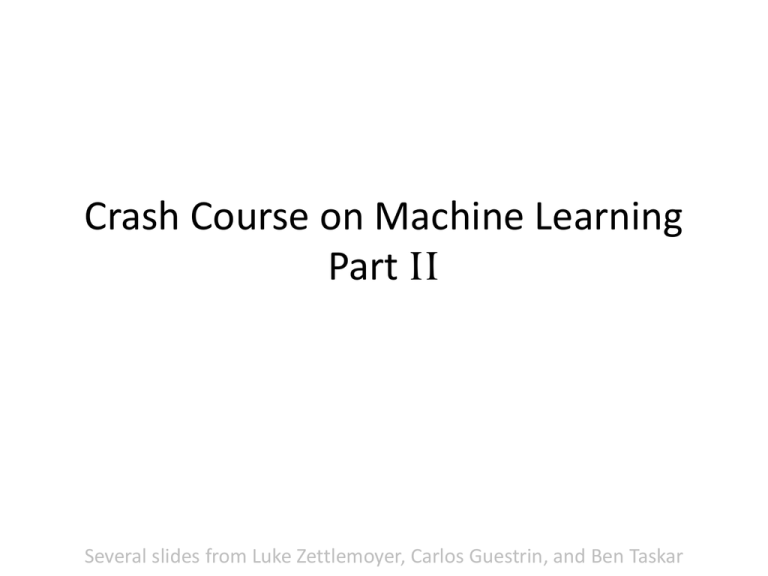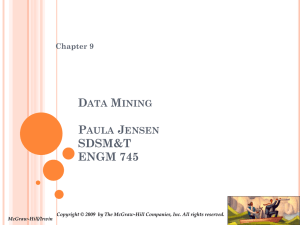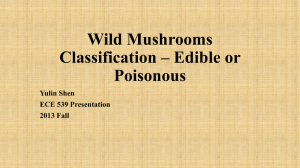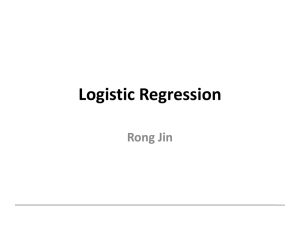Document
advertisement

Crash Course on Machine Learning
Part II
Several slides from Luke Zettlemoyer, Carlos Guestrin, and Ben Taskar
We have talked about…
• MLE
• MAP and Conjugate priors
• Naïve Bayes
another probabilistic approach!!!
• Naïve Bayes: directly estimate the data
distribution P(X,Y)!
– challenging due to size of distribution!
– make Naïve Bayes assumption: only need P(Xi|Y)!
• But wait, we classify according to:
– maxY P(Y|X)
• Why not learn P(Y|X) directly?
Discriminative vs. generative
• Generative model
0.1
(The artist)
0.05
0
• Discriminative model
(The lousy
painter)
0
10
20
30
40
0
10
20
30
40
0
10
20
30
40
50
60
70
50
60
70
50
60
70
x = data
1
0.5
0
x = data
• Classification function
1
-1
x = data
80
Logistic Regression
Logistic function (Sigmoid):
•
Learn P(Y|X) directly!
•
•
Assume a particular
functional form
Sigmoid applied to a
linear function of the
data:
Z
Logistic Regression: decision boundary
• Prediction: Output the Y with
highest P(Y|X)
– For binary Y, output Y=0 if
A Linear Classifier!
Loss functions / Learning Objectives:
Likelihood v. Conditional Likelihood
• Generative (Naïve Bayes) Loss function:
Data likelihood
• But, discriminative (logistic regression) loss function:
Conditional Data Likelihood
– Doesn’t waste effort learning P(X) – focuses on P(Y|X) all that matters
for classification
– Discriminative models cannot compute P(xj|w)!
Conditional Log Likelihood
equal because yj is in {0,1}
remaining steps: substitute definitions, expand logs, and simplify
Logistic Regression Parameter Estimation:
Maximize Conditional Log Likelihood
Good news: l(w) is concave function of w
→ no locally optimal solutions!
Bad news: no closed-form solution to maximize l(w)
Good news: concave functions “easy” to optimize
Optimizing concave function –
Gradient ascent
• Conditional likelihood for Logistic Regression is concave !
Gradient:
Update rule:
• Gradient ascent is simplest of optimization approaches
– e.g., Conjugate gradient ascent much better
Maximize Conditional Log Likelihood: Gradient ascent
Gradient Descent for LR
Gradient ascent algorithm: (learning rate η > 0)
do:
For i=1…n: (iterate over weights)
until “change” <
Loop over training examples!
Large parameters…
a=1
a=5
a=10
• Maximum likelihood solution: prefers higher weights
– higher likelihood of (properly classified) examples close to
decision boundary
– larger influence of corresponding features on decision
– can cause overfitting!!!
• Regularization: penalize high weights
– again, more on this later in the quarter
How about MAP?
• One common approach is to define priors
on w
– Normal distribution, zero mean, identity
covariance
• Often called Regularization
– Helps avoid very large weights and overfitting
• MAP estimate:
M(C)AP as Regularization
• Add log p(w) to objective:
– Quadratic penalty: drives weights towards zero
– Adds a negative linear term to the gradients
MLE vs. MAP
• Maximum conditional likelihood estimate
• Maximum conditional a posteriori estimate
Logistic regression v. Naïve Bayes
• Consider learning f: X Y, where
– X is a vector of real-valued features, < X1 … Xn >
– Y is boolean
• Could use a Gaussian Naïve Bayes classifier
– assume all Xi are conditionally independent given Y
– model P(Xi | Y = yk) as Gaussian N(ik,i)
– model P(Y) as Bernoulli(q,1-q)
• What does that imply about the form of P(Y|X)?
Cool!!!!
Derive form for P(Y|X) for continuous Xi
up to now, all arithmetic
only for Naïve Bayes models
Looks like a setting for w0?
Can we solve for wi ?
• Yes, but only in Gaussian case
Ratio of class-conditional probabilities
…
Linear function!
Coefficents expressed
with original
Gaussian parameters!
Derive form for P(Y|X) for continuous Xi
Gaussian Naïve Bayes vs. Logistic Regression
Set of Gaussian
Naïve Bayes parameters
(feature variance
independent of class label)
Set of Logistic
Regression parameters
Can go both ways,
we only did one
way
• Representation equivalence
– But only in a special case!!! (GNB with class-independent variances)
• But what’s the difference???
• LR makes no assumptions about P(X|Y) in learning!!!
• Loss function!!!
– Optimize different functions ! Obtain different solutions
Naïve Bayes vs. Logistic Regression
Consider Y boolean, Xi continuous, X=<X1 ... Xn>
Number of parameters:
• Naïve Bayes: 4n +1
• Logistic Regression: n+1
Estimation method:
• Naïve Bayes parameter estimates are uncoupled
• Logistic Regression parameter estimates are coupled
Naïve Bayes vs. Logistic Regression
[Ng & Jordan, 2002]
• Generative vs. Discriminative classifiers
• Asymptotic comparison
(# training examples infinity)
– when model correct
• GNB (with class independent variances) and
LR produce identical classifiers
– when model incorrect
• LR is less biased – does not assume conditional
independence
– therefore LR expected to outperform GNB
Naïve Bayes vs. Logistic Regression
[Ng & Jordan, 2002]
• Generative vs. Discriminative classifiers
• Non-asymptotic analysis
– convergence rate of parameter estimates,
(n = # of attributes in X)
• Size of training data to get close to infinite data solution
• Naïve Bayes needs O(log n) samples
• Logistic Regression needs O(n) samples
– GNB converges more quickly to its (perhaps less
helpful) asymptotic estimates
What you should know about Logistic
Regression (LR)
• Gaussian Naïve Bayes with class-independent variances
representationally equivalent to LR
– Solution differs because of objective (loss) function
• In general, NB and LR make different assumptions
– NB: Features independent given class ! assumption on P(X|Y)
– LR: Functional form of P(Y|X), no assumption on P(X|Y)
• LR is a linear classifier
– decision rule is a hyperplane
• LR optimized by conditional likelihood
– no closed-form solution
– concave ! global optimum with gradient ascent
– Maximum conditional a posteriori corresponds to regularization
• Convergence rates
– GNB (usually) needs less data
– LR (usually) gets to better solutions in the limit
26
Decision Boundary
27
Voting (Ensemble Methods)
• Instead of learning a single classifier, learn many
weak classifiers that are good at different parts of
the data
• Output class: (Weighted) vote of each classifier
– Classifiers that are most “sure” will vote with more
conviction
– Classifiers will be most “sure” about a particular part of the
space
– On average, do better than single classifier!
• But how???
– force classifiers to learn about different parts of the input
space? different subsets of the data?
– weigh the votes of different classifiers?
BAGGing = Bootstrap AGGregation
(Breiman, 1996)
• for i = 1, 2, …, K:
– Ti randomly select M training instances
with replacement
– hi learn(Ti) [ID3, NB, kNN, neural net, …]
• Now combine the Ti together with uniform
voting (wi=1/K for all i)
30
Decision Boundary
31
shades of blue/red indicate strength of vote for particular classification
Fighting the bias-variance tradeoff
• Simple (a.k.a. weak) learners are good
– e.g., naïve Bayes, logistic regression, decision
stumps (or shallow decision trees)
– Low variance, don’t usually overfit
• Simple (a.k.a. weak) learners are bad
– High bias, can’t solve hard learning problems
• Can we make weak learners always good???
– No!!!
– But often yes…
Boosting
[Schapire, 1989]
• Idea: given a weak learner, run it multiple times on
(reweighted) training data, then let learned classifiers vote
• On each iteration t:
– weight each training example by how incorrectly it was
classified
– Learn a hypothesis – ht
– A strength for this hypothesis – t
• Final classifier:
• Practically useful
• Theoretically interesting
time = 0
blue/red = class
size of dot = weight
weak learner =
Decision stub:
horizontal or vertical l
35
time = 1
this hypothesis has 15%
error
and so does
this ensemble, since
the ensemble contains
just this one hypothesis
36
time = 2
37
time = 3
38
time = 13
39
time = 100
40
time = 300
overfitting!
41
Learning from weighted data
• Consider a weighted dataset
– D(i) – weight of i th training example (xi,yi)
– Interpretations:
• i th training example counts as if it occurred D(i) times
• If I were to “resample” data, I would get more samples of
“heavier” data points
• Now, always do weighted calculations:
– e.g., MLE for Naïve Bayes, redefine Count(Y=y) to be weighted count:
– setting D(j)=1 (or any constant value!), for all j, will recreates
unweighted case
How? Many possibilities. Will
see one shortly!
Final Result: linear sum of
“base” or “weak” classifier
outputs.
What t to choose for hypothesis ht?
[Schapire, 1989]
Idea: choose t to minimize a bound on training error!
Where
What t to choose for hypothesis ht?
[Schapire, 1989]
Idea: choose t to minimize a bound on training error!
Where
And
This equality isn’t
obvious! Can be shown
with algebra
(telescoping sums)!
If we minimize t Zt, we minimize our training error!!!
• We can tighten this bound greedily, by choosing t and ht
on each iteration to minimize Zt.
• ht is estimated as a black box, but can we solve for t?
Summary: choose t to minimize error bound
[Schapire, 1989]
We can squeeze this bound by choosing t on each
iteration to minimize Zt.
For boolean Y: differentiate, set equal to 0, there is a
closed form solution! [Freund & Schapire ’97]:
Strong, weak classifiers
• If each classifier is (at least slightly) better than
random: t < 0.5
• Another bound on error:
• What does this imply about the training error?
– Will reach zero!
– Will get there exponentially fast!
• Is it hard to achieve better than random training error?
Boosting results – Digit recognition
[Schapire, 1989]
Test error
Training error
• Boosting:
– Seems to be robust to overfitting
– Test error can decrease even after
training error is zero!!!
Boosting generalization error bound
[Freund & Schapire, 1996]
Constants:
• T: number of boosting rounds
– Higher T Looser bound, what does this imply?
• d: VC dimension of weak learner, measures
complexity of classifier
– Higher d bigger hypothesis space looser bound
• m: number of training examples
– more data tighter bound
Boosting generalization error bound
[Freund & Schapire, 1996]
Constants:
• • Theory
does
not match
practice:
T: number
of boosting
rounds:
• –Robust
Higher Ttooverfitting
Looser bound, what does this imply?
set error decreases
even after
training error is
• • d:Test
VC dimension
of weak learner,
measures
zero
complexity of classifier
•
Need
better
analysis
toolsspace looser bound
– Higher
d bigger
hypothesis
comeofback
to this
later in the quarter
• • m:we’ll
number
training
examples
– more data tighter bound
Logistic Regression as Minimizing Loss
Logistic regression assumes:
And tries to maximize data likelihood, for Y={-1,+1}:
Equivalent to minimizing log loss:
Boosting and Logistic Regression
Logistic regression equivalent
to minimizing log loss:
Boosting minimizes similar loss
function:
Both smooth approximations of 0/1 loss!







